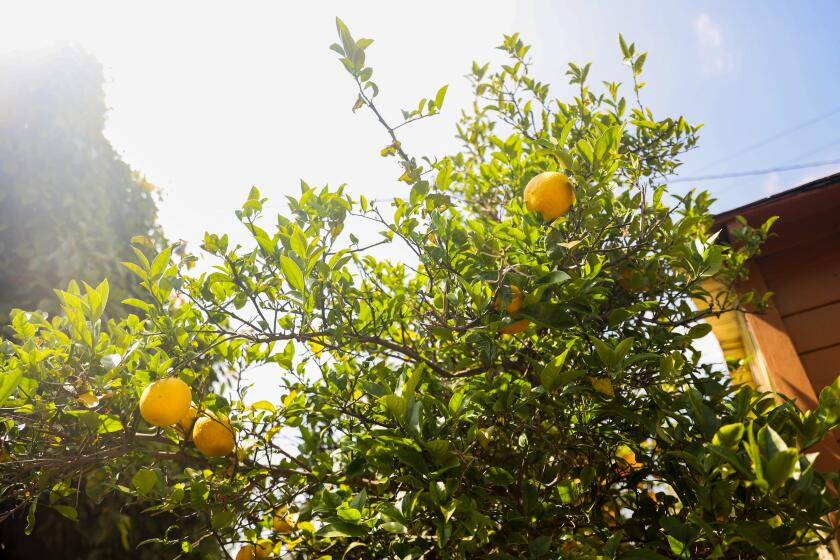This map tells you where to pick fruit in L.A. — even if the tree owners don’t know
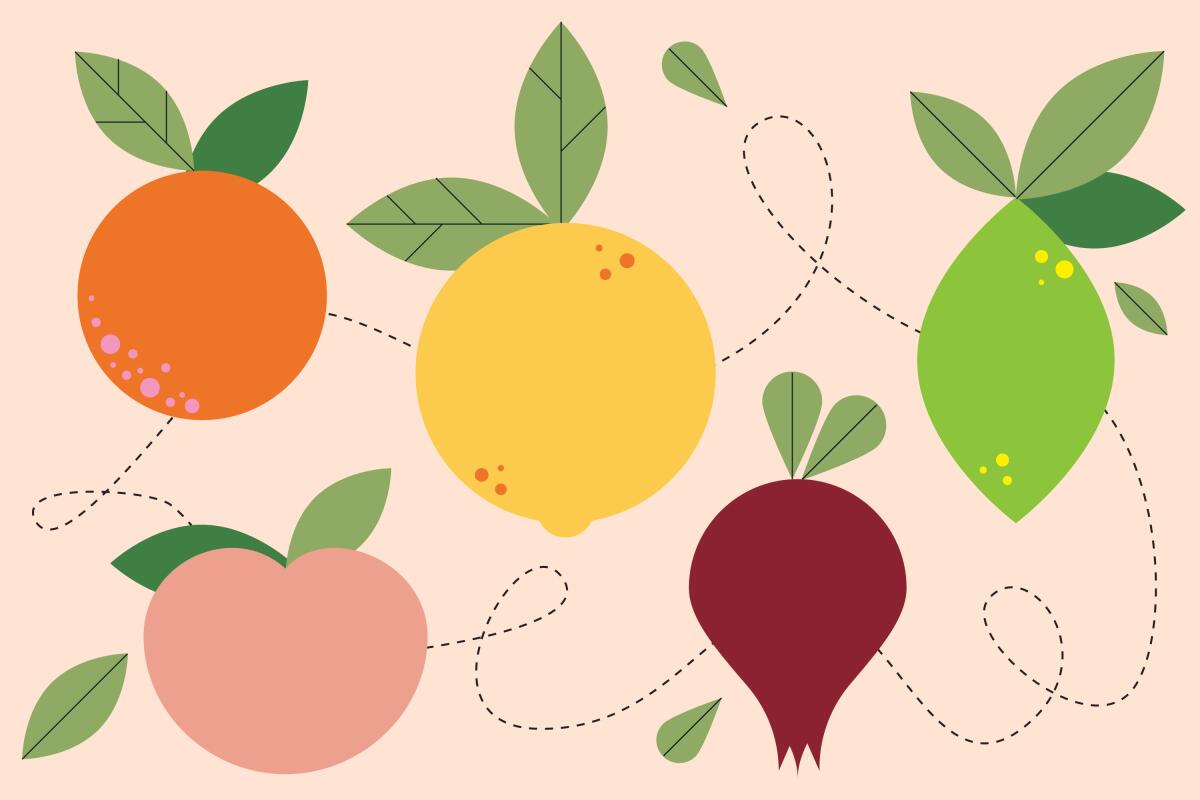
- Share via
Remember our long chilly spring, when we were wondering if summer would ever come? Well, welcome to August, where the heat just keeps coming.
There are still plenty of plant-related activities listed below, but first, I’d like to revisit a question we asked earlier this year about whether it’s ever OK to take fruit from someone else’s tree. Roughly half of the 800 people who responded came down in favor of helping themselves to fruit hanging into a public area, like a sidewalk or street. Only 19% answered with a hard no. Their position was pretty much, “My tree, my fruit, even if it’s hanging in a public space.”
More than 800 readers shared their thoughts on the etiquette of picking fruit from a tree that’s not their own. But what’s legal and should one consider Nextdoor shaming?
For those people, artist David Allen Burns, co-founder of the nonprofit fruit mapping project Fallen Fruit, has a provocative question: Do we really “own” the trees in our yards?

“I promise you won’t be living 100 years from now,” Burns said, “but that tree will still be here, so now what? How much of that tree is really yours?”
That got my back up a little bit, and also my conscience. A healthy fruit tree will produce thousands of pounds of fruit over our lifetimes, Burns said, “so how much of that can you really eat?”
Even the Bible has something to say about this, in Leviticus 19:10: “And thou shalt not glean thy vineyard, neither shalt thou gather the fallen fruit of thy vineyard; thou shalt leave them for the poor and for the stranger.”
That passage, by the way, is where Burns, and fellow co-founders Austin Young and Matias Viegener got the name for their Fallen Fruit project back in 2004 in response to a question from an art and activism journal: “Is it possible to do the right thing in the world and not make anyone else wrong?” Burns said.
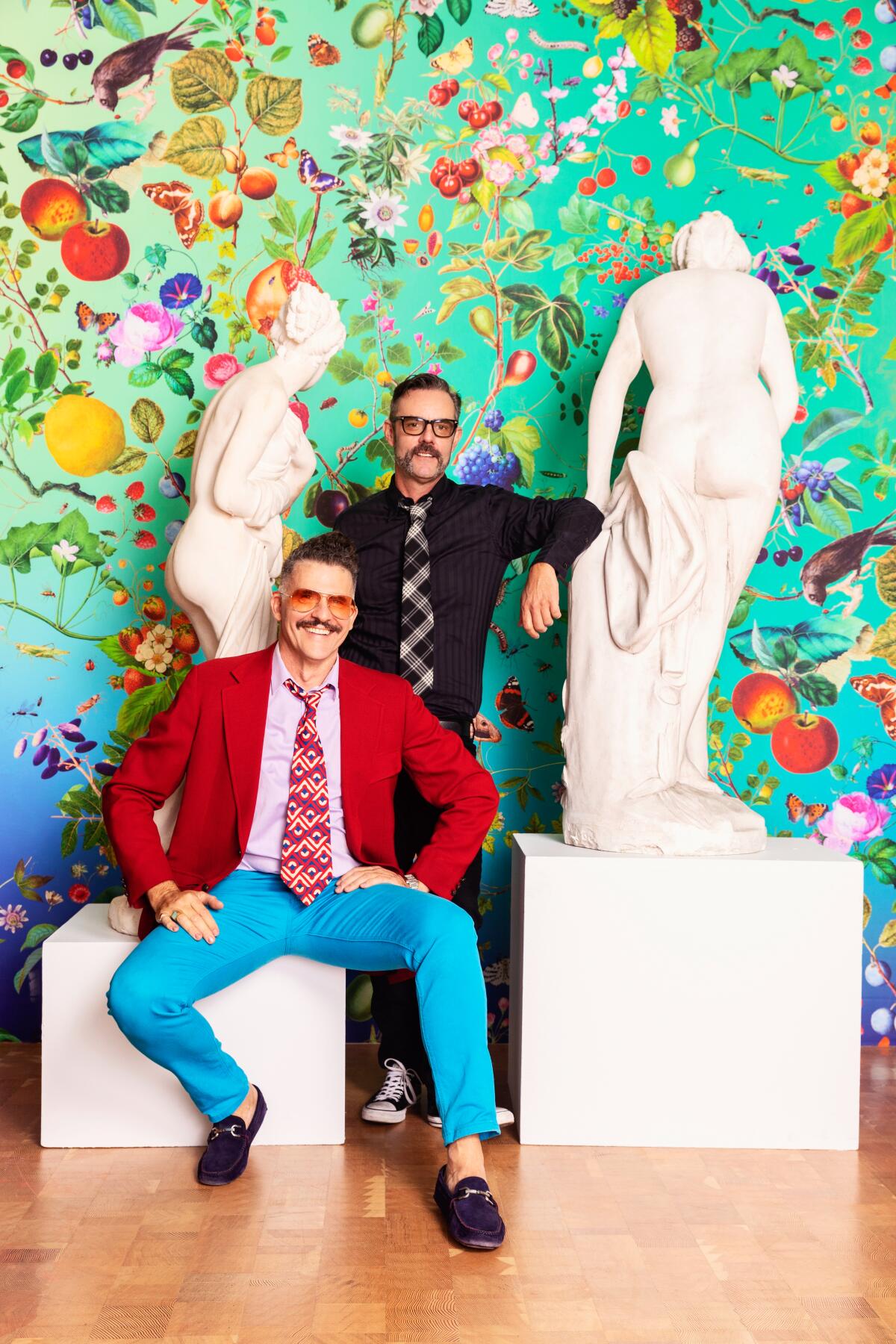
The artists then lived in Silver Lake (Burns has since moved to Lake Arrowhead) and walked their neighborhood trying to find an answer. “When we started paying attention, we learned there are over 100 fruit trees in five city blocks [in Silver Lake] being ignored, not picked or cared for, while people were getting in their cars and driving to Whole Foods or Trader Joes to buy fruit from another country,” Burns said. So they drew a map, without specific addresses, that indicated the locations of many types of fruit in their neighborhood.
They didn’t include fruit growing within the boundaries of a yard — only fruit hanging in public areas, said Young. If you have to reach into someone’s yard to pick the fruit, that’s trespassing, he said.
But their project was still pretty radical. They advocated for the city to plant fruit trees for shade, beauty and public consumption, and let people plant food in parkways. (It was illegal in L.A. until Fallen Fruit and Ron Finley, the self-dubbed Gangsta Gardener, came along.) They also suggested planting public orchards, and requiring homeowners to plant trees in their yards for the sole purpose of feeding people who are hungry.
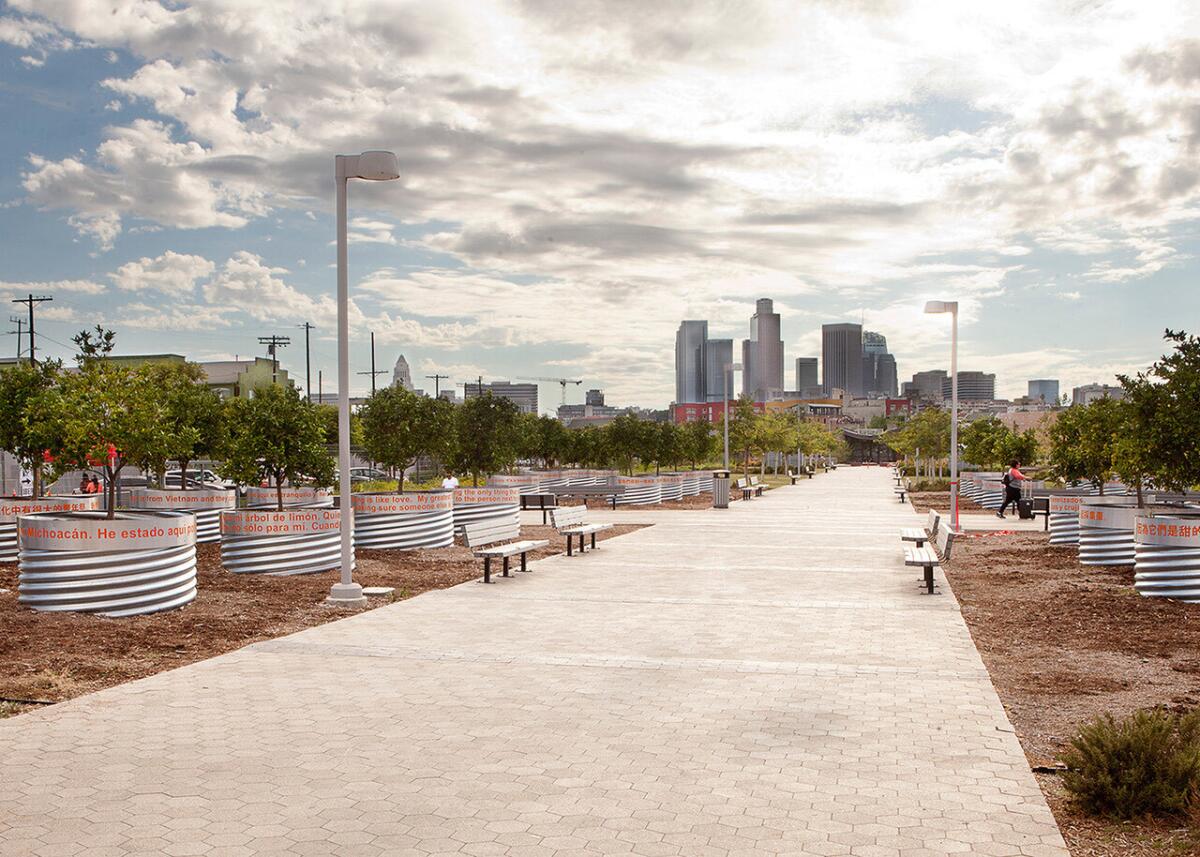
Over the last 20 years, Young and Burns have done their best to bring this vision to life around the world (Viegener’s participation ended in 2013). They’ve created public orchards around the world, in places like New York, Italy and Mexico, as well as local installations at Del Aire Park in Hawthorne, Stoneview Nature Center in Culver City and Los Angeles State Historic Park in Chinatown, where their Monument to Sharing of 32 Valencia orange trees includes quotes from nearby residents.
They’ve passed out hundreds of fruit trees, with only one requirement — that some of their branches hang in a public space for others to pick.
Why does Southern California have so many residential fruit trees? Credit the weather, developers, even the Gold Rush. Plus: a list of plant-related June events.
And they created the Endless Orchard, an interactive map where they and others can identify locations of publicly accessible fruit. And they aren’t alone — there are other fruit foraging sites that map publicly accessible fruit, such as Fruitmap, based in Poland, and Falling Fruit, based in Boulder, Colo. Both map fruit in multiple locations, including Los Angeles, but their websites can feel buggy.
So what’s it like to be on a fruit map? I checked in with about a half dozen people in the San Fernando Valley. None of them knew about the fruit map and most didn’t want to talk about people who might be picking their easily accessible fruit.

In Lake Balboa, however, Tony Sinicropi, a.k.a Tony Rockwood, a graphic artist and clothing designer, said he doesn’t mind sharing the fruit off his massive orange and grapefruit trees that grow in the parkway outside his home. The trees produce prolifically, which is handy since the lower branches are picked clean of ripe fruit. But Sinicropi doubts the pickers are consulting a map; he thinks they most likely live, work or go to school nearby.
He’s fine with neighbors picking his fruit, Sinicropi said, but he would prefer strangers ask first, and then only take a few at a time. His biggest gripe is the garbage people leave around his trees, but making a map of fruit locations? “That’s probably a bad idea,” Sinicropi said, “because you can’t trust people.”
Burns disagrees. Fallen Fruit’s motto is to take what you need and leave some for others. It also encourages asking permission, if only to make a connection, and maybe even a friendship. “What’s wrong with being friendly?” he said.
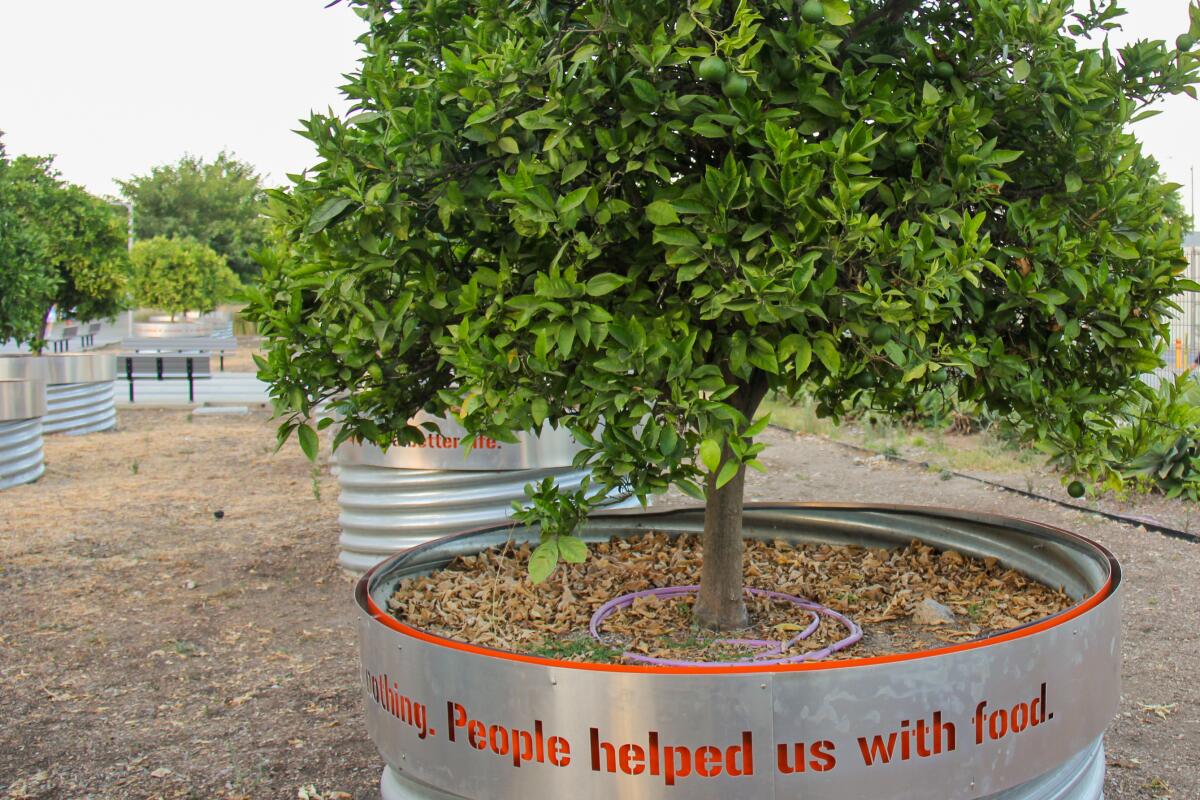
Ultimately, most people want to share, Burns said. “I was raised that if you have something, you break it in half and share it.”
If asked, Fallen Fruit will remove locations from its map, but it has only had a couple of requests in 20 years, Burns said. Falling Fruit won’t remove locations but will note if an owner has asked people to steer clear. Fruitmap’s website doesn’t provide a clear way to make this request.
At the end of our conversation, Sinicropi urged me to take as many grapefruits as I wanted. I found two plump fruit on the ground and squeezed them that evening. The juice was perfect; tart, refreshing and all the sweeter for being a gift.
You’re reading the L.A. Times Plants newsletter
Jeanette Marantos gives you a roundup of upcoming plant-related activities and events in Southern California, along with our latest plant stories.
You may occasionally receive promotional content from the Los Angeles Times.
Upcoming events
Aug. 2-4
38th Inter-City Cactus & Succulent Show & Sale, 9 a.m. to 5 p.m. at the Los Angeles County Arboretum in Arcadia, hosted by the Long Beach Cactus Club, Los Angeles Cactus and Succulent Society and the San Gabriel Valley Cactus and Succulent Society. The sale includes 24 vendors all three days. The show runs Aug. 3-4 only and will include more than 1,500 exhibits. Free with $15 admission to the Arboretum ($11 for seniors 62+ and students with school I.D.s, $5 ages 5-12, members and children 4 and younger enter free.) arboretum.org
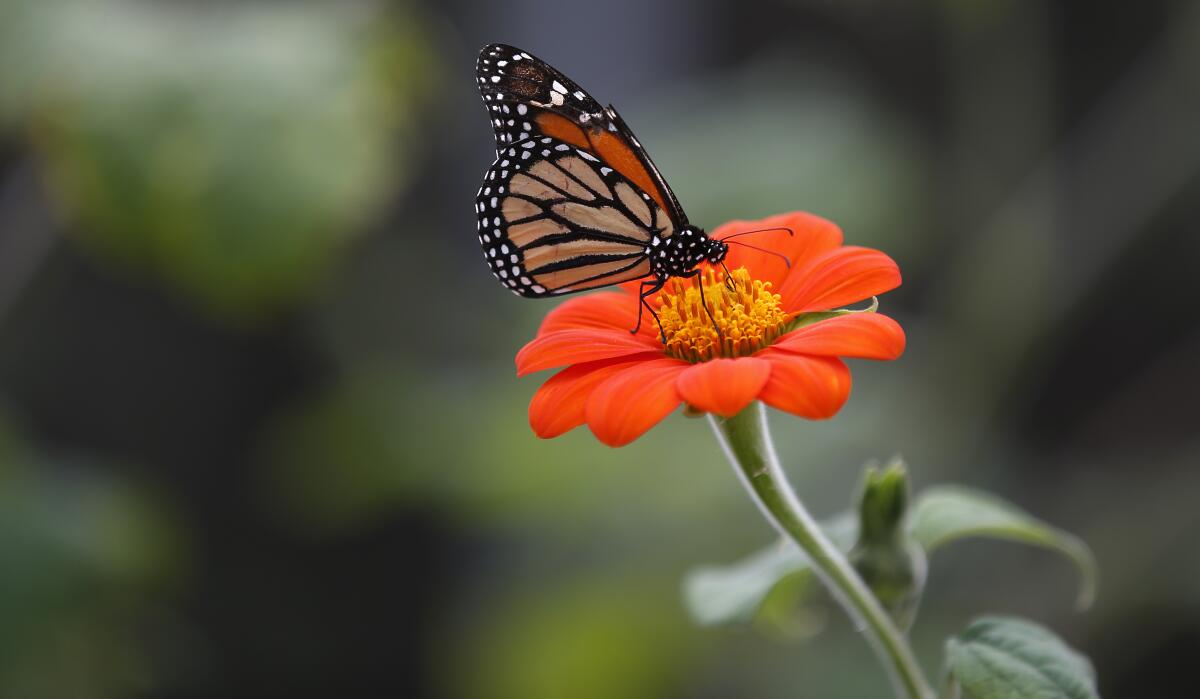
Aug. 3
Tree of Life Nursery’s 10th Festival of the Butterflies,10 a.m. to 4 p.m. at Los Rios Park in San Juan Capistrano. The free event includes a children’s butterfly parade, a hat contest, food, music and gardening talks about creating sustainable butterfly gardens and other topics. californianativeplants.com
Into the Plantiverse at the Los Angeles County Arboretum’s Summer Camp for Adults, 4 to 8 p.m. at the Arboretum in Arcadia, an exploration of “super plant villains” and plants that inspired (or could inspire) comic book characters. The event includes a lunchbox of nostalgic camp foods (such as Goldfish crackers) and an “adult juice box” of wine. Participants must be 21 or older. Tickets are $65 ($60 for members) and must be reserved in advance. arboretum.org
Aug. 3, 10 and 17
Palos Verdes Peninsula Land Conservancy Monthly Guided Nature Walks. Learn about wildlife in the George F. Canyon Nature Preserve at 10:30 a.m. on Aug. 3; El Segundo blue butterflies and their coastal sage scrub habitat on Aug. 10; and wildlife around the White Point Nature Preserve at 10:30 a.m. on Aug. 17. The family-friendly walks are free but participants must register in advance. pvplc.org
Aug. 9
City Plants Shade Tree Adoption at Hansen Dam, 3 to 9 p.m. in Sylmar, allows city of Los Angeles residents to adopt up to seven shade trees for free. Recipients must bring photo I.D. with a city address as proof of residence. cityplants.org

Aug. 10, 17 and 24
Three-Part California Native Garden Design taught by landscape designer Carol Armour Aronson of Seco Verde Inc., 9 a.m. to 1 p.m. each day at the Theodore Payne Foundation in Sun Valley. The foundation’s Right Plant, Right Place, an online introduction to native plant gardening, is a prerequisite for the design course. It’s being taught on Aug. 2 from 10:30 a.m. to 12:30 p.m. for $35 ($25 for members). People wanting to take the three-part design course must register by Aug. 2. Tickets are $348.65 for individuals ($295.29 for members) or $412.67 ($359.32) for couples. eventbrite.com
Aug. 11
South Coast Cactus & Succulent Society presents Soil and Fertilizer for Succulents, a presentation by Peter W Plants Nursery owner Peter Walkowiak of San Diego during the society’s monthly meeting at 1 p.m. at the South Coast Botanic Garden in Rolling Hills Estates. Admission is free to members and their guests; membership is $20 per year. southcoastcss.org
Friends of the LA River present River Fest 2024 from 3 to 9 p.m. at the Los Angeles State Historic Park in Chinatown, a free open-air environmental arts and community festival celebrating the history and people of the Los Angeles River. Expect ecological activities for all ages, live performances, an art gallery, marketplace and food trucks. General admission is free with advance registration; VIP tickets are $125 for special parking, seating and drink tickets (21 or older only). support.folar.org
Row Reset at Black Thumb Farm, 9 to 11 a.m. in Panorama City. Learn about regenerative farming while helping this nonprofit farm rake, fertilize and rebuild rows with compost. Free but advance registration is required. portal.caclimateactioncorps.org
Aug. 16
East Meets West: An Ikebana Workshop with California Native Plants taught by Japanese artist Hiromi Sutton, 10 a.m. to noon at the Theodore Payne Foundation in Sun Valley. All plant materials will be provided to learn the basics of ikebana (Japanese floral arranging), but participants should bring their own “kaki” — a vase, bowl or plate of their liking — to hold the arrangement. Tickets are $71.21 ($60.54 for members). eventbrite.com
Aug. 17
Moss Wall Art Workshop, 11 a.m. to 12:30 p.m. at Rolling Greens in Studio City. Create a wall hanging from moss and take it home. Tickets are $225 and include all materials and wine from Cosette Wine Bar. rollinggreens.com
Flower Printing, 10 a.m. to noon at Black Thumb Farm in Panorama City. Karla Mejia of Sol Y Raíz explains how to dye cotton fabric with fresh flowers grown on the farm. Tickets are $25 to $40, depending on ability to pay. artofprovocations.squarespace.com
Rather than buy mom flowers for Mother’s Day, take her to a Los Angeles-area nursery to pick up the perfect plant — and then help her place it in her yard or in a pot.
Aug. 18
Native Wildlife in the Garden, 10 a.m. to noon at the Black Thumb Farm in Panorama City. A California Wildlife Center workshop about plants that attract and support native wildlife. Admission is by donation, but registration is required. eventbrite.com
Aug. 22
Propagating California Native Plants from Seed, taught by Theodore Payne Foundation’s Seed Program Manager Genevieve Arnold, 9 a.m. to noon at the foundation in Sun Valley. Participants will take home all the seeds they’ve sown and get a tour of the foundation’s facilities. Tickets are $92.55 ($81.88 for members). eventbrite.com
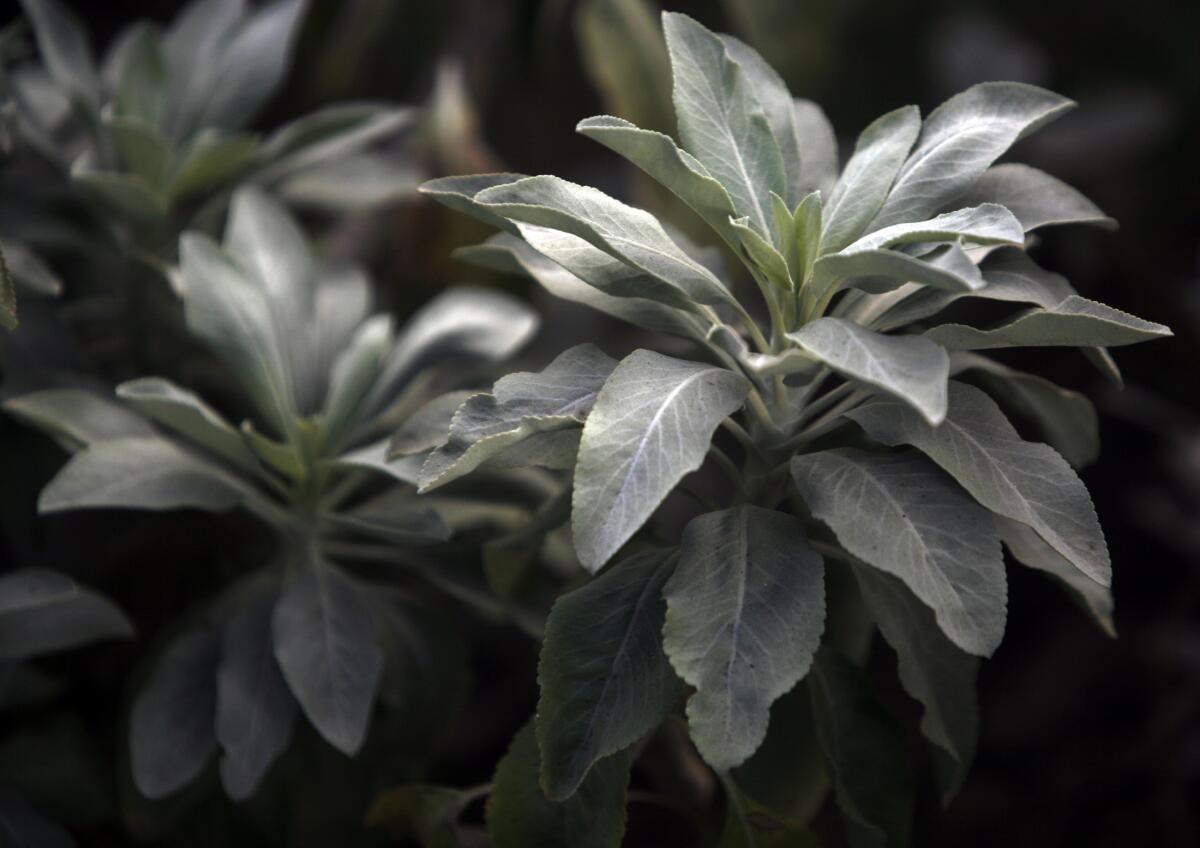
Aug. 23
Comprehensive Irrigation for California Native Plants taught by Theodore Payne Foundation Horticulture Director Tim Becker, 9 a.m. to noon at the foundation in Sun Valley. Tickets are $71.21 ($60.54 for members). eventbrite.com
Aug. 24
Friends of the LA River Habitat Restoration Day, 8 to 11 a.m. at the Sepulveda Basin Wildlife Preserve in the Sepulveda Basin, in partnership with the California Native Plant Society and San Fernando Valley Audubon. The event includes invasive plant removal and bird walks in the preserve. Admission is free, but advance registration is required. Gloves and weeding tools will be provided but participants are welcome to bring their own. eventbrite.com
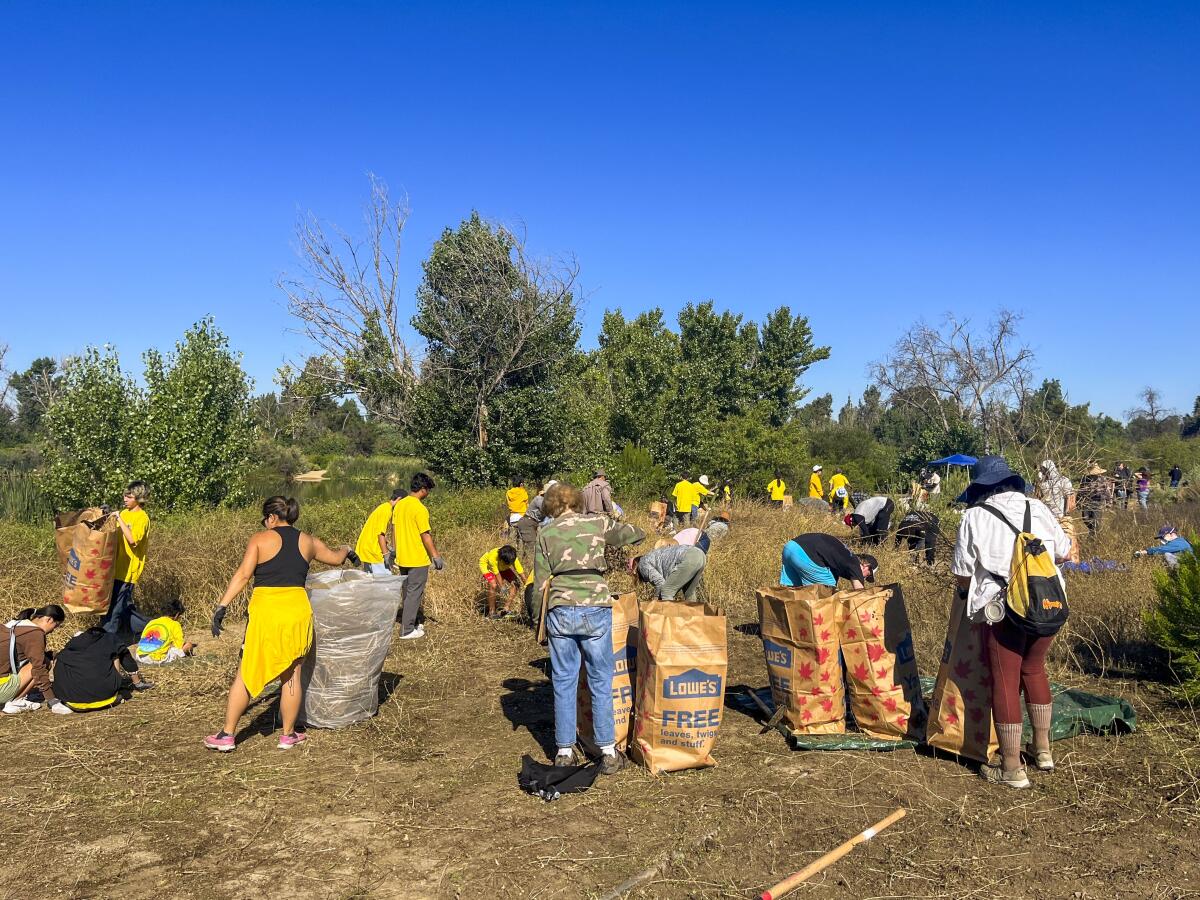
Santa Barbara County Farm Day, 10 a.m. to 3 p.m. at 15 locations in Santa Barbara County. Sign up for free self-guided tours and demonstrations at multiple locations, including organic farms, wineries, walnut groves, cattle ranches, berry farms and produce warehouses. Tickets are free but advance registration is required. santabarbaracountyfarmday.com
Aug. 24-25
Hibiscus and Plumeria Show and Sale, 10:30 a.m. to 4 p.m. at Sherman Library & Gardens in Corona del Mar, presented by the Southern California Hibiscus Society and the South Coast Plumeria Society. Admission is free with $5 entry to the garden. (Free for members and children 3 and under.) thesherman.org
Aug. 30
Intro to California Native Plant Garden Design taught by Theodore Payne Foundation Horticulture Director Tim Becker, 9 a.m. to noon at the foundation in Sun Valley. Tickets are $60.54 ($55.20 for members). eventbrite.com
Consider subscribing to the Los Angeles Times
Your support helps us deliver the news that matters most. Become a subscriber.
What we’re reading
I always wanted a water feature in my yard, but the cost and mechanics were too intimidating. Then I got inspired after talking to people who made their own, and took the plunge. Result: I made myself a gurgling fountain (after a weekend and $130 in parts and materials)!
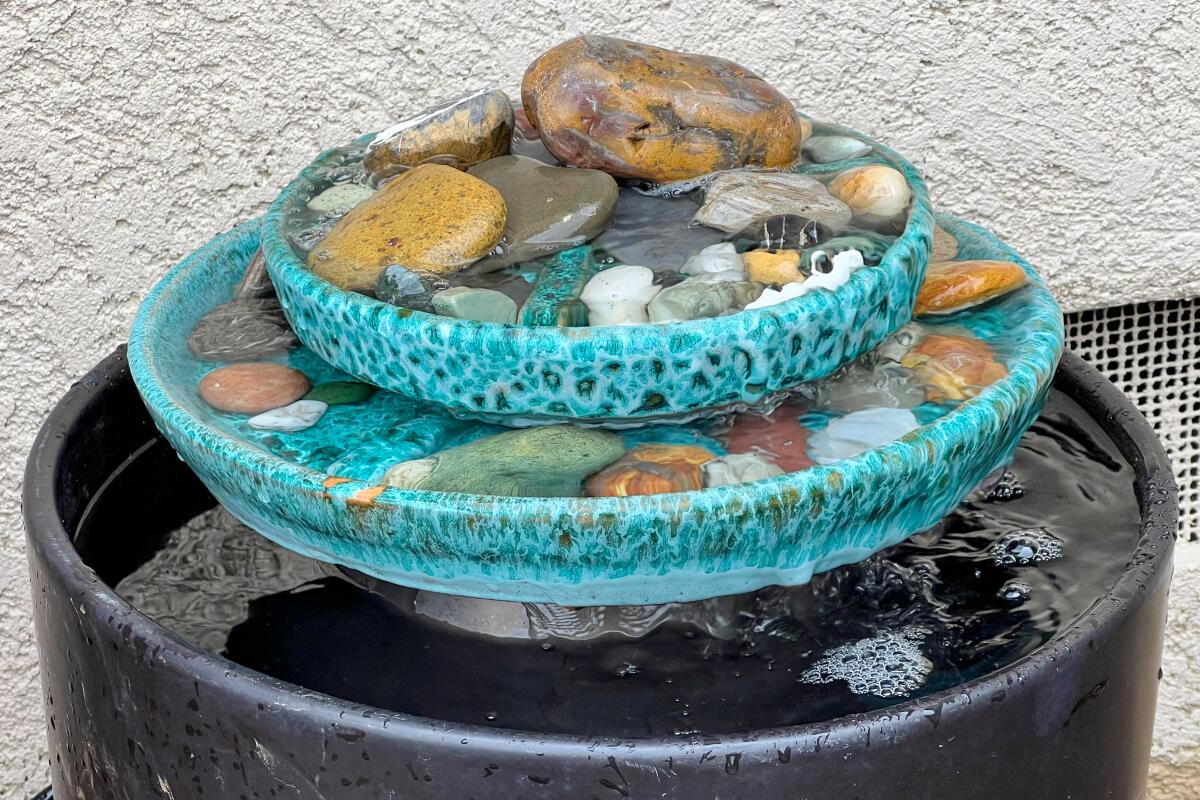
Speaking of water, Todd Martens, our resident theme park guru, put together a great guide to the best water rides in Southern California, if you’re yearning for something wilder than a wading pool or home water slide.
And of course, there’s always the beach. My colleagues and I put together this handy guide to Southern California’s 50 best beaches, if you want to explore.
If you’ve taken the Theodore Payne Foundation’s Native Plant Garden Tour, you’ve likely visited the magical Casa Apocalyptica. Owners Chris Elwell and Kory Odell dish about how they created this weird and wonderful landscape of native plants and salvaged rubble.
Finally, our intrepid cannabis reporter Adam Tschorn recorded a historic plant-related event this summer: the California State Fair’s first-ever cannabis consumption lounge. And yes, it was everything you imagine.
Sign up for The Wild
We’ll help you find the best places to hike, bike and run, as well as the perfect silent spots for meditation and yoga.
You may occasionally receive promotional content from the Los Angeles Times.

